How Music Influences Emotional Recovery: The Healing Soundtrack of the Mind
Introduction
When words fail, music speaks. 🎶 Whether it’s the steady beat of a drum, a soothing piano melody, or the lyrics of a song that mirror your soul, music has a unique power to reach the deepest layers of human emotion. Across cultures and centuries, people have turned to music to process grief, celebrate joy, and heal from pain.
But beyond its poetic allure, science increasingly supports what many instinctively know: music can influence emotional recovery — from heartbreak, trauma, anxiety, or depression — by reshaping brain pathways, regulating hormones, and restoring a sense of balance.
Let’s explore how and why music is such a profound tool for emotional healing, and how you can consciously use it to support your own recovery journey.
Looking for supplements for Emotional Recovery? Click here.
🎧 The Science of Music and Emotion
Music doesn’t just “make us feel.” It physically alters the brain. Neurological research shows that when you listen to music you love, neurotransmitters like dopamine, serotonin, and oxytocin are released. These chemicals are directly tied to pleasure, motivation, and connection — all essential for emotional resilience.
🧠 Dopamine: The Reward Chemical
When you hear a song that gives you chills, that’s dopamine at work. This “feel-good” neurotransmitter boosts motivation and reward processing, helping lift you out of emotional numbness or fatigue.
💞 Oxytocin: The Bonding Hormone
Singing — especially in groups — triggers oxytocin release. This hormone enhances trust, empathy, and social connection, which are vital for healing from emotional isolation or trauma.
🌙 Cortisol and Stress Reduction
Music has been shown to lower cortisol, the primary stress hormone. Slow-tempo music activates the parasympathetic nervous system, calming your heart rate and breathing — essentially telling your body: You are safe.
🎶 The Brain’s Integration Effect
Music activates multiple areas of the brain simultaneously — the auditory cortex, limbic system (emotions), and prefrontal cortex (decision-making). This integration fosters emotional regulation and cognitive flexibility, two cornerstones of recovery.
“Music can change the brain in ways that medication cannot.”
— Oliver Sacks, neurologist and author of Musicophilia
💔 How Music Aids Emotional Recovery After Loss or Trauma

Emotional recovery isn’t linear — it ebbs and flows. Music provides a safe space to experience and express complex emotions that words can’t capture.
🎵 Step 1: Music as Emotional Validation
When you’re grieving or struggling, hearing a song that reflects your pain helps you feel understood. This validation is the first step in healing.
Example: Sad ballads can mirror heartbreak without judgment, allowing you to process emotion instead of suppressing it.
💬 It’s okay to feel this — the song feels it too.
💧 Step 2: Music as Emotional Release
Tears often come more easily with music. That’s not weakness — it’s regulation. Crying while listening to music helps discharge emotional tension and resets the nervous system.
🪶 Studies show that music-induced crying releases oxytocin and activates parasympathetic calm, restoring balance after emotional overload.
🌤️ Step 3: Music as Motivation for Recovery
Over time, you may shift from melancholic songs toward more uplifting or empowering ones. This natural progression mirrors your emotional resilience growing stronger.
For instance:
Early recovery: “Sad songs that understand.”
Mid recovery: “Reflective, hopeful songs.”
Later stage: “Energetic, empowering tracks.”
This musical journey reflects the healing process itself — from darkness to light, from chaos to coherence. 🌈
🎼 The Therapeutic Power of Sound
Music therapy is now an established clinical field used in hospitals, rehab centers, and trauma recovery programs. But even outside formal therapy, the principles of sound healing can be applied in daily life.
🎶 1. Music Therapy
Music therapy involves guided listening, songwriting, or instrument playing with a trained therapist. It’s used to help patients with PTSD, depression, or brain injury reconnect with emotion and rebuild cognitive function.
Example:
Stroke survivors who can’t speak may regain language through singing (a technique called melodic intonation therapy).
Trauma patients often use drumming to release pent-up energy safely.
🧘 Sound Healing and Vibrational Therapy
Sound therapy uses frequencies and tones (e.g., singing bowls, tuning forks) to rebalance the body’s energy. The vibrations help regulate brain waves, often guiding you into theta states — the brainwave range linked to creativity, deep relaxation, and emotional release.
💫 Think of it as “massage for the nervous system.”
🌊 Binaural Beats and Frequency-Based Music
Binaural beats use slightly different frequencies in each ear to influence brain activity. For example:
4–8 Hz → theta waves (deep relaxation, healing)
8–12 Hz → alpha waves (calm focus)
These frequencies can accelerate recovery from anxiety and emotional burnout by promoting balanced brainwave synchronization.
💡 The Emotional Stages of Healing Through Music
Emotional recovery often unfolds like a symphony — with distinct movements. Here’s how music can support each stage:
Shock / Disconnection 😶
In the early stage after emotional pain or trauma, the nervous system is overwhelmed.
Music Role: Gentle ambient or instrumental tracks help regulate breathing and reconnect you to bodily sensations.
🎧 Examples:
“Weightless” by Marconi Union
Piano or cello solos with slow tempos
Acknowledgment / Expression 😢
Once numbness fades, emotions emerge. This can be painful — but it’s necessary.
Music Role: Emotionally resonant songs act as companions in grief or anger.
🎧 Examples:
Adele – “Someone Like You”
Bon Iver – “Skinny Love”
Billie Eilish – “Everything I Wanted”
💬 Let the lyrics say what you can’t.
Integration / Understanding 🌱
Here, reflection replaces raw emotion. Music helps make sense of what happened and who you’re becoming.
Music Role: Acoustic or storytelling music invites introspection and forgiveness.
🎧 Examples:
Norah Jones – “Come Away With Me”
Coldplay – “The Scientist”
Growth / Reconnection 🌞
You start feeling lighter, rediscovering purpose. Music now energizes rather than consoles.
Music Role: Uplifting rhythms, percussion, or inspiring lyrics reawaken vitality.
🎧 Examples:
Florence + The Machine – “Dog Days Are Over”
Kygo – “Firestone”
Any instrumental world music with upbeat flow
Empowerment / Renewal 🌻
You’ve rebuilt your emotional identity. Music becomes a reflection of your strength.
Music Role: Empowering or spiritual tracks help sustain optimism and gratitude.
🎧 Examples:
Sia – “Unstoppable”
Beyoncé – “Halo”
Trevor Hall – “The Lime Tree”
Music doesn’t erase pain — it transforms how you carry it.
🫀 Music, Memory, and the Healing Brain
Music is uniquely tied to memory. That’s why a single song can transport you to a moment from years ago — evoking emotion faster than words or images.
🎶 The Hippocampus Connection
The hippocampus (memory center) is highly active during music listening. For trauma survivors, music can gently reintroduce memories in a non-threatening way, helping them integrate past experiences.
In Alzheimer’s and dementia care, familiar songs have been shown to restore lucidity and emotional recognition, proving how deeply music is wired into the human brain.
🧠 Even when language fades, melody remains.
💫 The Role of Rhythm: Healing Through Movement
The human heartbeat is rhythmic; our breathing, walking, even speech follow rhythmic patterns. When rhythm is disrupted by trauma or depression, music can re-stabilize it.
🥁 Drumming and Emotional Regulation
Drumming synchronizes heart rate and brainwaves, grounding you in the present. Group drumming has been shown to reduce PTSD symptoms, increase self-expression, and promote a sense of belonging.
“Rhythm reconnects what trauma disconnects.” — Bessel van der Kolk, The Body Keeps the Score
💃 Music and Movement Therapy
Dance therapy combines rhythm and physical expression to process emotion nonverbally. Moving to music helps release stored trauma from muscles and fascia — the body’s emotional memory storage.
💃 Even simple swaying or walking to the beat of a favorite song can discharge nervous tension.
🌈 Music and Neuroplasticity: Rewiring for Resilience

Neuroplasticity — the brain’s ability to reorganize itself — is essential for emotional recovery. Music stimulates neuroplasticity by forging new connections between brain regions responsible for mood, memory, and motor control.
🎧 Studies show that consistent music engagement:
Enhances emotional regulation.
Increases grey matter volume in the hippocampus.
Improves connectivity between hemispheres.
This means music doesn’t just help you feel better — it helps your brain heal better. 🧠
🪷 Music for Anxiety and Depression
Music therapy is a recognized complementary treatment for anxiety and depression. The right tempo and frequency can stabilize mood, slow heart rate, and increase parasympathetic activity.
🎵 For Anxiety
Use slow, predictable rhythms (60–80 bpm).
Avoid abrupt tempo changes or dissonant sounds.
Try instrumental or nature-infused music.
🧘 Tip: Pair calming music with deep breathing for a double soothing effect.
🎵 For Depression
Begin with music that matches your emotional state, then gradually introduce more uplifting pieces.
Singing releases endorphins and improves self-esteem.
🎤 Tip: Start your day with songs that evoke warmth or hope, even softly.*
🧘 Integrating Music Into Emotional Healing Practices
You don’t need to be a musician to benefit from music therapy principles. Here’s how to weave music into your healing routine:
🌅 Morning: Uplift and Align
Choose instrumental or lyrical songs that gently energize without overstimulating.
🎧 Examples: acoustic guitar, lo-fi beats, ambient piano.
🪞 Use music while journaling intentions or gratitude to set an emotional tone for the day.
☀️ Midday: Regulate and Refocus
When tension builds, listen to rhythmic tracks that promote flow and focus — like jazz, chillstep, or soft percussion.
💨 Try pairing with breathwork: inhale for 4 beats, exhale for 6.
🌙 Evening: Calm and Restore
End the day with binaural beats, chanting, or soft classical music. These stimulate alpha and theta brainwaves for relaxation and emotional integration.
🕯️ Use headphones, close your eyes, and let sound become your anchor.
🪶 Singing as Self-Therapy
Your voice is one of the most direct healing tools you have. When you sing, vibrations travel through your skull and chest, massaging the vagus nerve — the main regulator of your stress response.
🎤 Benefits of Singing for Emotional Recovery
Increases oxygen flow and lung capacity.
Boosts oxytocin (connection) and endorphins (joy).
Balances heart rate variability.
Even humming has measurable calming effects. Try humming before bed or during anxious moments — your body will remember safety through sound.
🌻 Collective Healing Through Music
Community music — choirs, drum circles, festivals — fosters emotional recovery through shared rhythm and belonging. When voices or beats synchronize, individual nervous systems begin to co-regulate, creating harmony both musically and biologically.
🤝 In trauma healing, this sense of communal rhythm helps replace isolation with connection — one of the deepest human needs.
“We are wired to heal in rhythm, not in isolation.”
🌅 Cultural Roots of Music and Healing
Every culture has used music for healing:
🪶 Indigenous drumming for spirit alignment.
🕊️ Gregorian chants for spiritual peace.
🌺 Indian ragas to balance emotional energy.
🌊 African polyrhythms for community cohesion.
These traditions show that healing through sound is not new — it’s ancient wisdom rediscovered through modern science.
💬 The Lyrics That Heal
Sometimes, it’s not just the melody — it’s the message. Lyrics that speak to endurance, hope, or forgiveness can accelerate emotional recovery by reframing internal narratives.
🎶 Example lyric themes for healing playlists:
“I survived.” (Resilience)
“I forgive.” (Release)
“I will rise.” (Empowerment)
“I’m not alone.” (Connection)
🧠 The brain encodes lyrical affirmations like mantras — turning music into subconscious therapy.
🧘 Combining Music with Other Healing Practices
Music integrates seamlessly with holistic and therapeutic approaches:
| Practice | Role of Music |
|---|---|
| Meditation | Supports focus, lowers brainwave frequency |
| Yoga | Enhances flow and breath synchronization |
| Breathwork | Guides pace and intensity of breathing |
| Therapy sessions | Opens emotional access and self-expression |
| Nature walks | Amplifies grounding and mindfulness |
💡 Tip: Match music tempo to your heartbeat — slow it down to calm, speed it up to energize.*
🌸 Creating Your Emotional Recovery Playlist
Design your playlist like a healing journey:
Grounding songs — gentle, safe, familiar.
Emotionally expressive songs — allow release.
Reflective songs — bring insight and meaning.
Uplifting songs — rekindle motivation.
Empowering songs — reinforce self-worth and strength.
🪶 Example structure:
“River Flows in You” (peace)
“Fix You” by Coldplay (emotion)
“Rise Up” by Andra Day (hope)
“Brave” by Sara Bareilles (strength)
Each song becomes a step on your healing ladder. 🎵
💫 Music as a Mirror and a Medicine
Music doesn’t heal by “fixing” you. It heals by reflecting who you are — your sadness, your longing, your joy — and helping you integrate all those parts into one coherent whole.
In moments of pain, it holds you. In moments of hope, it lifts you. And in silence between notes, it reminds you that healing often happens not through force, but through gentle resonance.
“Music expresses that which cannot be said and on which it is impossible to be silent.” — Victor Hugo
🌻 Final Thoughts: Composing Your Emotional Recovery
Healing is not a straight line — it’s a song with verses, pauses, and refrains. 🎶
Some days, your melody may sound uncertain. On others, it will soar. What matters is that you keep listening — to the music, to your body, to your heart.
Because music is more than entertainment.
It’s remembrance.
It’s medicine.
It’s the bridge back to yourself. 💚
Looking for supplements for Emotional Recovery? Click here.
📚 References
Thoma, M. V., et al. (2013). The effect of music on the human stress response. PLoS ONE.
Koelsch, S. (2014). Brain correlates of music-evoked emotions. Nature Reviews Neuroscience.
Chanda, M. L., & Levitin, D. J. (2013). The neurochemistry of music. Trends in Cognitive Sciences.
Garrido, S., & Schubert, E. (2011). Individual differences in the enjoyment of negative emotion in music. PLoS ONE.
Bensimon, M., et al. (2012). Drumming through trauma: Music therapy with PTSD patients. The Arts in Psychotherapy.
Blood, A. J., & Zatorre, R. J. (2001). Intensely pleasurable responses to music correlate with brain activity in reward and emotion areas. PNAS.
Levitin, D. J. (2006). This Is Your Brain on Music. Penguin Books.
Van der Kolk, B. A. (2014). The Body Keeps the Score: Brain, Mind, and Body in the Healing of Trauma. Viking.
Gick, M. L. (2011). Singing, health, and well-being: A health psychologist’s review. Psychomusicology.
Magee, W. L., et al. (2017). Music therapy assessment tool for awareness in disorders of consciousness. Neuropsychological Rehabilitation.
Related Posts
-
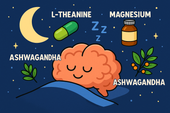
Nootropics That Promote Calm and Rest
Explore the world of calming nootropics — natural brain enhancers that promote relaxation, better focus, and deeper rest. Learn how L-Theanine, magnesium, ashwagandha, and other adaptogens help balance your nervous system, reduce stress, and support restorative sleep.
-

Best Natural Supplement Stack for Sleep
Discover the best natural supplement stack for deep, restorative sleep. Learn how nutrients like magnesium, L-theanine, glycine, and calming herbs such as chamomile and ashwagandha work together to relax your body, calm your mind, and improve sleep quality—naturally and safely.
-
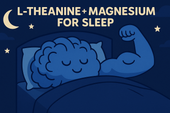
Combining L-Theanine and Magnesium for Sleep: A Calm Night, Naturally
Discover how combining L-Theanine and Magnesium can help you drift into deep, restorative sleep. Learn how this natural duo calms the mind, relaxes the body, and supports your nervous system—without grogginess the next morning.
-

How to Sleep Better After Intense Workouts
Struggling to fall asleep after a tough workout? Learn how to optimize your post-training recovery with nutrition, hydration, and science-backed sleep strategies. Discover how to calm your nervous system, balance hormones, and wake up fully recharged for your next session.
-

Ashwagandha and Valerian: A Bedtime Combo for Deep Rest and Emotional Reset
Discover the calming synergy of Ashwagandha and Valerian root, two natural sleep aids that help quiet the mind, ease anxiety, and promote deeper rest. Learn how this herbal duo supports the nervous system, balances stress hormones, and restores emotional peace — without next-day grogginess.
-

How to Create a Resilience-Boosting Diet
Discover how to build emotional and physical strength from the inside out with a resilience-boosting diet 🍎. Learn which foods stabilize your mood, how supplements like magnesium and omega-3s strengthen your stress response, and why pairing nutrition with breathwork and therapy creates lasting calm, focus, and vitality 🌿💪.
-

Best Teas and Herbal Blends for Calmness: Nature’s Way to Restore Inner Peace
Ashwagandha, the ancient adaptogenic herb, helps your body find balance during stress. Known as “Indian ginseng,” it supports cortisol regulation, boosts energy, and restores calm clarity. Discover how this powerful root promotes resilience, emotional balance, and steady vitality — one cup at a time. 🌸
-

Parenting and Emotional Strength: How to Raise Children Without Losing Yourself
Empathy is the bridge that connects hearts — the quiet power to understand, feel, and support another’s emotions without judgment. Learn how empathy strengthens relationships, enhances communication, and cultivates deeper compassion in everyday life. 🌿
-
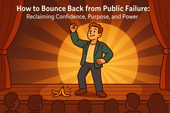
How to Bounce Back from Public Failure: Reclaiming Confidence, Purpose, and Power
Visualization is more than imagination — it’s brain training for resilience. By picturing calm, success, or healing, you activate the same neural pathways as real experience. Learn how daily visualization rewires your brain for confidence, emotional balance, and recovery from stress. ✨
-

Coping with Financial Stress Through Resilience: How to Stay Grounded When Money Feels Tight
Body awareness is the foundation of emotional resilience. By tuning into your body’s signals — tension, fatigue, or calm — you learn to recognize stress before it overwhelms you. Discover how mindfulness, gentle movement, and breathwork can deepen your connection with your body and restore balance from the inside out. 🧘
-

How to Stay Positive During Chronic Illness: A Guide to Emotional Strength and Hope
Creativity is more than art — it’s a form of healing. Whether through painting, writing, music, or small acts of expression, creativity helps release emotion, calm the nervous system, and reconnect you to joy. Discover how to use creativity as a tool for emotional balance, resilience, and self-discovery. 🌿
-
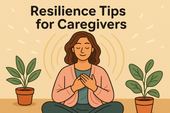
Resilience Tips for Caregivers: How to Stay Strong While Caring for Others
Joy isn’t the absence of pain — it’s the quiet strength to find light even in challenging times. Cultivating joy through small daily moments restores balance, releases stress, and reminds you of life’s beauty. Learn how to reconnect with authentic happiness, rebuild emotional energy, and nurture your nervous system through gratitude, presence, and play. 🌿
-

Building Resilience After a Breakup: How to Heal, Rebuild, and Rise Stronger
Social connection is one of the strongest predictors of emotional resilience. During difficult times, genuine relationships act as anchors — calming the nervous system, reducing stress hormones, and helping you regain perspective. Learn how cultivating real human connection can strengthen your mind, heart, and overall well-being. 🌿
-

How to Stay Emotionally Strong During Job Loss
Your emotions are powered by brain chemistry — a delicate balance of neurotransmitters like serotonin, dopamine, and cortisol. When these chemicals work in harmony, you feel calm, focused, and resilient. Learn how daily habits, nutrition, and mindfulness can support your brain chemistry and boost emotional well-being naturally. 🌿
-
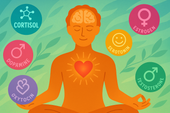
The Role of Hormones in Emotional Stability: How Your Chemistry Shapes Your Calm
Hormones shape more than your body — they shape your emotions, resilience, and sense of calm. From cortisol to serotonin, these chemical messengers influence how you react to stress, connect with others, and recover from challenges. Learn how to balance your hormones naturally to build lasting emotional stability and harmony within. 💫
-
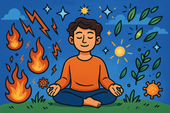
Mitochondria and Emotional Energy: The Cellular Power Behind Your Mood
Breathwork is one of the most powerful tools for emotional regulation and cellular balance. Through intentional breathing, you can calm your nervous system, increase oxygen flow to the brain, and even support mitochondrial energy. Learn how conscious breathing connects body and mind — transforming stress into presence and emotional strength. 🌿
-
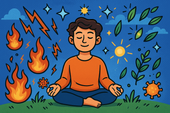
Inflammation and Its Impact on Mood Resilience: The Silent Link Between Body and Mind
Inflammation doesn’t just affect the body — it impacts the mind. Chronic inflammation alters brain chemistry, depletes serotonin, and makes emotional recovery harder. Learn how calming inflammation through nutrition, mindfulness, and sleep can restore balance, resilience, and a renewed sense of emotional strength. 💫
-
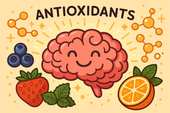
How Antioxidants Protect Emotional Well-being: The Hidden Link Between Oxidative Stress and Mental Health
Antioxidants do more than protect your body — they defend your mind. By neutralizing oxidative stress, antioxidants support serotonin, dopamine, and brain energy pathways that keep you calm, focused, and emotionally balanced. Discover how foods like berries, green tea, and dark chocolate nourish your brain, boost mood, and strengthen resilience from the inside out. 🌿✨
-
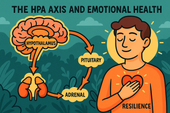
The HPA Axis and Emotional Health: The Hidden Bridge Between Stress and Mind
Neuroplasticity — the brain’s ability to rewire and adapt — is the foundation of emotional healing and resilience. When you face stress, trauma, or change, your neural pathways can reshape themselves to support new patterns of calm, focus, and self-awareness. Learn how daily practices like mindfulness, therapy, and breathwork strengthen neuroplasticity to transform emotional pain into personal growth. 🌸
-
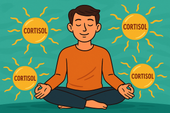
Why Cortisol Control Is Key to Resilience: Mastering Stress to Build Emotional Strength
Controlling cortisol — the body’s main stress hormone — is the secret to lasting resilience. When cortisol levels stay balanced, your mind becomes clearer, emotions steadier, and energy more sustainable. Learn how breathwork, mindset shifts, adaptogens, and daily rhythms can help you calm your stress response and build true inner strength. 🌞💪
-
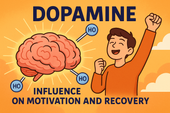
Dopamine’s Influence on Motivation and Recovery: Reigniting Drive and Balance
Healthy relationships are the foundation of emotional balance and resilience. Whether romantic, familial, or platonic, genuine connection releases dopamine, serotonin, and oxytocin — the brain’s “bonding trio” — helping us feel secure, motivated, and seen. Learn how trust, empathy, and communication not only strengthen your connections but also reshape your nervous system for deeper emotional well-being. 🌿🤝
-
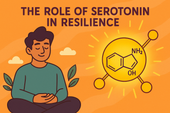
The Role of Serotonin in Resilience: How This “Mood Molecule” Shapes Emotional Strength
Serotonin — often called the “resilience molecule” — plays a vital role in how we handle stress, regulate mood, and recover from emotional challenges. Beyond happiness, this powerful neurotransmitter helps balance the gut-brain axis, stabilize the nervous system, and support emotional flexibility. Learn how nutrition, sunlight, mindfulness, and adaptogens can naturally boost serotonin and strengthen your emotional resilience. 🌞🧠
-
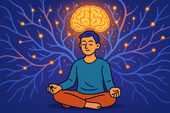
How Neuroplasticity Supports Emotional Growth: Rewiring the Brain for Resilience
Neuroplasticity is the brain’s built-in power to grow, adapt, and heal — and it’s the foundation of emotional transformation. Every mindful breath, compassionate act, or reframed thought strengthens new neural pathways that support resilience and self-awareness. Learn how your brain rewires through daily habits, helping you turn emotional challenges into opportunities for growth and calm. 🌿
-

Tai Chi and Adaptogens for Mind-Body Balance: The Art of Harmonizing Energy and Resilience
Alchemy isn’t just an ancient science — it’s a timeless symbol of transformation and inner balance. By blending the physical and spiritual, alchemy teaches us that change begins from within. Just as metals are refined into gold, we too can transmute emotional pain, stress, and chaos into clarity and strength through mindful practice and self-awareness. 🌙✨
-

Cold Therapy and Emotional Control: Training the Mind Through the Body
Cold therapy isn’t just for athletes — it’s a tool for emotional mastery. By exposing your body to controlled cold, you train your nervous system to stay calm under stress, improving focus, mood, and resilience. This article explores the science of cold exposure, its impact on hormones and the vagus nerve, and how ice baths and cold showers can help you build emotional control, one breath at a time. 🧊🧘♂️
-
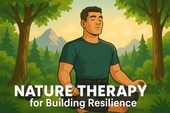
Nature Therapy for Building Resilience: Reconnecting With the Healing Power of the Earth
Nature therapy helps rebuild emotional resilience by reconnecting you with the healing rhythms of the Earth. From forest walks to sunlight exposure, nature restores balance to your nervous system, lowers stress hormones, and teaches emotional adaptability. Learn how spending time outdoors can enhance mental clarity, calm anxiety, and awaken your natural capacity to heal. 🌞
-

Breathwork Techniques That Pair with Supplements: The Ultimate Synergy for Stress Relief and Mental Clarity
Breathwork and supplements create a powerful mind-body synergy for stress relief, focus, and energy. By combining intentional breathing with adaptogens, nootropics, and calming nutrients, you can naturally regulate cortisol, sharpen mental clarity, and boost emotional balance. This guide explores the best breathwork techniques and supplement pairings to help you feel centered, calm, and energized from the inside out. 🌿
-
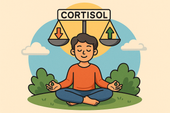
Why Cortisol Balance Matters for Emotional Strength
Balancing cortisol — your body’s main stress hormone — is essential for emotional resilience. When cortisol is chronically high, your mind stays stuck in survival mode, leading to fatigue, anxiety, and emotional instability. This article explores how nutrition, supplements, breathwork, and therapy can help restore healthy cortisol rhythms, regulate the nervous system, and strengthen your ability to handle life’s challenges with calm focus and emotional strength. 🌿
-

Best Supplements for Students During Exam Season: Focus, Energy, and Memory Support
Studying late into the night? Learn which natural supplements can boost focus, memory, and mental stamina during exam season — without the crash. From omega-3s to Bacopa and Rhodiola, discover your brain’s ultimate exam support stack. 🎓🧠
-
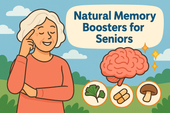
Natural Memory Boosters for Seniors: How to Keep Your Mind Sharp and Focused
Stay mentally sharp and confident as you age. Discover science-backed natural supplements and lifestyle habits that boost memory, focus, and brain longevity for seniors. 🌿🧠
-
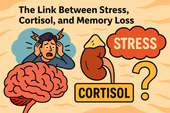
The Link Between Stress, Cortisol, and Memory Loss
Chronic stress can quietly erode your memory — and cortisol is the key culprit. Learn how stress hormones affect the brain, why the hippocampus shrinks under pressure, and how natural strategies can help you restore memory and mental clarity. 🧠✨
-
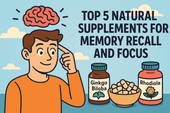
How to Build a Daily Supplement Routine for Memory Health
Want to sharpen your memory and stay mentally clear? Learn how to build a daily supplement routine for memory health — from morning focus to nighttime brain repair. Discover science-backed nutrients that boost recall, focus, and long-term cognitive resilience. 🧠🌿
-
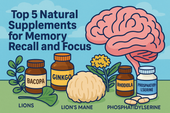
Top 5 Natural Supplements for Memory Recall and Focus
Looking to boost memory and concentration naturally? Discover the top 5 supplements — Bacopa, Ginkgo Biloba, Lion’s Mane, Rhodiola, and Phosphatidylserine — that enhance focus, recall, and long-term brain health. 🧠✨
-
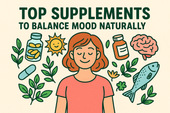
Top Supplements to Balance Mood Naturally
From omega-3s to adaptogens, discover the top natural supplements proven to support emotional balance, reduce stress, and promote inner calm — safely and effectively. 🌿✨
-
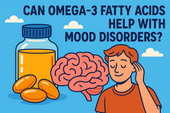
Can Omega-3 Fatty Acids Help with Mood Disorders?
Omega-3 fatty acids do more than support heart health — they can help balance mood, reduce depression, and calm anxiety. Discover how EPA and DHA nourish your brain, fight inflammation, and support emotional well-being from within. 🌊🧠
-

Vitamin D and Mood: The Sunshine Vitamin for Emotional Balance
Could the key to emotional balance be as simple as a little sunlight? Discover how vitamin D — the sunshine vitamin — influences serotonin, reduces inflammation, and helps you feel more positive and resilient year-round. ☀️💛
-

The Role of Magnesium in Reducing Irritability and Low Mood
Feeling on edge or emotionally drained? Magnesium could be the missing link between your body and your mood. Discover how this essential mineral reduces irritability, balances neurotransmitters, and helps your nervous system find calm again. 🌿✨
-
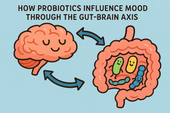
How Probiotics Influence Mood Through the Gut-Brain Axis
Discover how probiotics can do more than support your digestion—they can actually uplift your mood. This article explores the fascinating gut-brain axis and how balancing your gut bacteria through probiotics may help reduce anxiety, improve emotional stability, and support long-term mental well-being. 🌿🧠
-
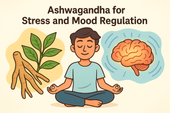
Ashwagandha for Stress and Mood Regulation
Discover how Ashwagandha, the powerful adaptogenic herb 🌿, helps your body manage stress and regulate mood. Learn how it balances cortisol, boosts GABA and serotonin, and supports emotional stability — helping you feel calm, focused, and resilient every day.
-
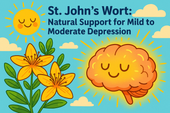
St. John’s Wort: Natural Support for Mild to Moderate Depression
Discover how St. John’s Wort, the “sunshine herb” 🌼, naturally supports mild to moderate depression. Learn how it boosts serotonin, balances mood, and promotes emotional resilience — with research showing its effectiveness compares to antidepressants, but with fewer side effects.
-
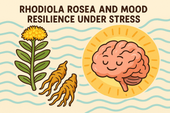
Rhodiola Rosea and Mood Resilience Under Stress
Discover how Rhodiola rosea helps your body adapt to stress 🌿. Learn how this powerful adaptogen balances cortisol, supports serotonin and dopamine, and strengthens emotional resilience — helping you stay calm, focused, and energized under pressure.
-

Chamomile and Lavender: Herbal Calm for Emotional Fluctuations
Discover how chamomile and lavender bring calm to emotional ups and downs 🌿. Learn how these two soothing herbs balance your nervous system, ease anxiety, and support restful sleep — naturally helping you find peace and emotional stability.
-
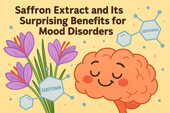
Saffron Extract and Its Surprising Benefits for Mood Disorders
Discover how saffron extract — the golden spice of joy 🌸 — can naturally support mood balance, ease anxiety, and lift mild depression. Learn what science says about its serotonin-boosting power, the ideal dosage, and how this ancient remedy compares to modern antidepressants.
-
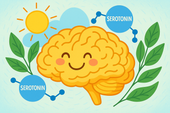
5-HTP and Serotonin: A Natural Path to Lifting Mood
Discover how 5-HTP naturally boosts serotonin 🌞 — the neurotransmitter behind mood, sleep, and emotional balance. Learn how this plant-derived compound supports happiness, reduces anxiety, and improves rest by helping your brain create more serotonin the gentle, natural way.
-
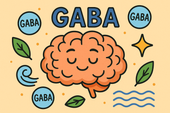
GABA Supplements for Reducing Anxiety and Mood Swings
Discover how GABA supplements can help reduce anxiety and balance mood naturally 🌿. Learn how this calming neurotransmitter works to quiet the mind, ease stress, and improve sleep — plus which nutrients and habits can boost your body’s own GABA production for long-term emotional stability.
-
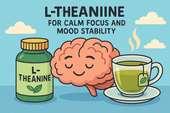
L-Theanine for Calm Focus and Mood Stability
Discover how L-theanine, the calming compound found in green tea 🍵, promotes focus, relaxation, and mood stability. Learn the science behind how it balances neurotransmitters, reduces stress hormones, and enhances clarity — helping you stay centered, calm, and productive without sedation.
-
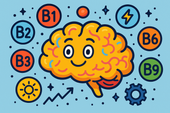
B Vitamins and Brain Chemistry: Supporting Energy and Emotional Balance
Discover how B vitamins power your brain chemistry ⚡. Learn how B6, B9, and B12 support serotonin, dopamine, and energy production — helping boost focus, mood, and emotional balance. From diet to supplements, explore how this vital nutrient group keeps your mind resilient and your energy steady.
-

N-Acetyl Cysteine (NAC) and Mood Disorders: What the Research Says
Learn how N-Acetyl Cysteine (NAC) supports brain health and mood balance 🧠. Discover how this antioxidant helps reduce oxidative stress, regulate glutamate, and improve emotional stability in depression, bipolar disorder, and anxiety — backed by cutting-edge psychiatric research.
-

Supplements for Bipolar Disorder: What May Support Stability
Discover the best supplements for bipolar disorder 🌿 that may support emotional stability and brain health. Learn how nutrients like omega-3s, magnesium, vitamin D, and NAC can help reduce inflammation, balance neurotransmitters, and complement traditional treatment safely.

















































